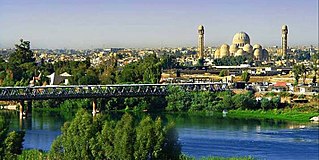
Mosul is a major city in northern Iraq, serving as the capital of Nineveh Governorate. The city is considered the second largest city in Iraq in terms of population and area after the capital Baghdad, with a population of over 3.7 million. Mosul is approximately 400 km (250 mi) north of Baghdad on the Tigris river. The Mosul metropolitan area has grown from the old city on the western side to encompass substantial areas on both the "Left Bank" and the "Right Bank", as locals call the two riverbanks. Mosul encloses the ruins of the ancient Assyrian city of Nineveh on its east side.
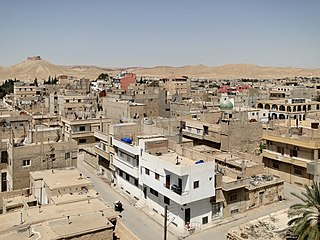
Palmyra is a city in central Syria, administratively part of the Homs Governorate. It is located in an oasis in the middle of the Syrian Desert 215 kilometres (134 mi) northeast of Damascus and 180 kilometres southwest of the Euphrates River. The ruins of ancient Palmyra, a UNESCO World Heritage Site, are situated about 500 metres southwest of the modern city centre. Relatively isolated, the nearest localities include Arak to the east, Al-Sukhnah further to the northeast, Tiyas to the west and al-Qaryatayn to the southwest.
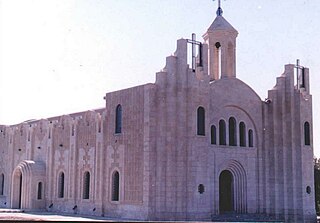
Bartella is a town that is located in the Nineveh Plains in northern Iraq, about 21 kilometres east of Mosul.

The Islamic State (IS), also known as the Islamic State of Iraq and the Levant, Islamic State of Iraq and Syria, and by its Arabic acronym Daesh, is a militant Islamist group and former unrecognized quasi-state that follows the Salafi jihadist branch of Sunni Islam. It was founded by Abu Musab al-Zarqawi in 1999 and gained global prominence in 2014, when it drove Iraqi security forces out of key cities during the Anbar campaign, which was followed by its capture of Mosul and the Sinjar massacre.

Al-Qaryatayn, also spelled Karyatayn, Qaratin or Cariatein, is a town in central Syria, administratively part of the Homs Governorate located southeast of Homs. It is situated on an oasis in the Syrian Desert. Nearby localities include Tadmur (Palmyra) to the northeast, Furqlus to the north, al-Riqama and Dardaghan to the northwest, Mahin, Huwwarin and Sadad to the west, Qarah, Deir Atiyah and al-Nabk to the southwest and Jayrud to the south. Al-Qaryatayn translates as "the two villages".
The genocide of Christians by the Islamic State involves the systematic mass murder of Christian minorities, within the regions of Iraq, Syria, Egypt and Libya controlled by the Islamic terrorist group Islamic State. Persecution of Christian minorities climaxed following the Syrian civil war and later by its spillover.
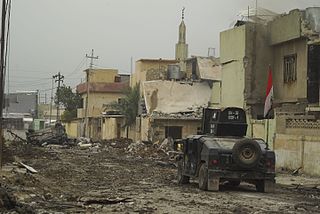
The War in Iraq was an armed conflict between Iraq and its allies and the Islamic State which began in 2013 and ended in December 2017. Following December 2013, the insurgency escalated into a full-scale war following the conquest of Ramadi, Fallujah, Tikrit and other towns in the major areas of northern Iraq by the Islamic State. Between 4–9 June 2014, the city of Mosul was attacked and later captured, following that, former Prime Minister Nuri al-Maliki called for a national state of emergency on 10 June. However, despite the security crisis, Iraq's parliament did not allow Maliki to declare a state of emergency; many legislators boycotted the session because they opposed expanding the prime minister's powers. Ali Ghaidan, a former military commander in Mosul, accused al-Maliki of being the one who issued the order to withdraw from the city of Mosul. At its height, ISIL held 56,000 square kilometers of Iraqi territory, containing 4.5 million citizens.

In response to rapid territorial gains made by the Islamic State during the first half of 2014, and its universally condemned executions, reported human rights abuses and the fear of further spillovers of the Syrian Civil War, many states began to intervene against it in both the Syrian Civil War and the War in Iraq. Later, there were also minor interventions by some states against IS-affiliated groups in Nigeria and Libya.

Beginning in 2014, a number of people from various countries were beheaded by the Islamic State; a radical Sunni Islamist group operating in Iraq and parts of Syria.
An Islamic State of Iraq and Syria (ISIS) cell composed of four British militants was nicknamed "the Beatles" after the British rock group the Beatles by their hostages; the members were nicknamed "John", "Paul", "George", and "Ringo" after the musicians.

Operation Shader is the operational code name given to the contribution of the United Kingdom in the ongoing military intervention against the Islamic State of Iraq and the Levant. The operation involves the British Army providing ground support and training to allied forces fighting against ISIL, the Royal Air Force providing humanitarian aid airdrops, reconnaissance and airstrikes, and the Royal Navy providing reconnaissance and airstrikes from the UK Carrier Strike group and escort to allied carrier battle groups. Additionally, UK Special Forces have reportedly operated in Iraq, Syria, Libya and Tunisia.
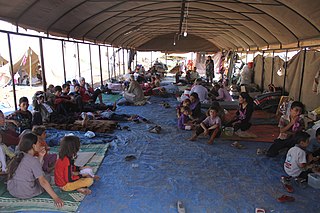
The state of human rights in the Islamic State of Iraq and the Levant (ISIL/ISIS) is considered to be one of, if not, the worst in modern history and has been severely criticised by many political and religious organisations, and individuals. Islamic State policies included severe acts of genocide, torture and slavery. The United Nations Commission on Human Rights (UNCHR) has stated that the Islamic State "seeks to subjugate civilians under its control and dominate every aspect of their lives through terror, indoctrination, and the provision of services to those who obey". ISIS actions of extreme criminality, terror, recruitment and other activities has been documented in the Middle East and several other regions around the world.
Deliberate destruction and theft of cultural heritage has been conducted by the Islamic State of Iraq and Syria since 2014 in Iraq, Syria, and to a lesser extent in Libya. The destruction targets various places of worship under ISIL control and ancient historical artifacts. In Iraq, between the fall of Mosul in June 2014 and February 2015, ISIS had plundered and destroyed at least 28 historical religious buildings. Valuable items from some buildings were looted in order to smuggle and sell them to foreigners to finance the running of the Islamic State. By March 2019, ISIS had lost most of its territory in the Middle East.

The Palmyra offensive of May 2015 was a military operation launched during the Syrian Civil War by the Islamic State of Iraq and the Levant (ISIL) on May 13–26, 2015, in an attempt to capture the government-held Tadmur District of the Homs Governorate, including the administrative centre of Tadmur, known in English as Palmyra. The ruins and ancient monuments of Palmyra, which lie on the south-western fringe of the modern city, have been a UNESCO World Heritage Site since 1980. The ruins were part of a desert oasis that was one of the most significant cultural centers of the ancient world, linking the civilizations of Persia, India, China with the Roman Empire through trade. The offensive was one of the largest offensives launched by ISIL, the largest one conducted by ISIL in Syria since the 2014 Eastern Syria offensive, with the result of the offensive increasing ISIL's control of Syria to at least 50%.
This article contains a timeline of events from January 2015 to December 2015 related to the Islamic State of Iraq and the Levant (ISIL/ISIS). This article contains information about events committed by or on behalf of the Islamic State, as well as events performed by groups who oppose them.
The persecution of Shia Muslims by the Islamic State refers to the persecution of Shia Muslims by the Islamic extremist group Islamic State (IS), which took place in Iraq, Syria, and other areas across the world.
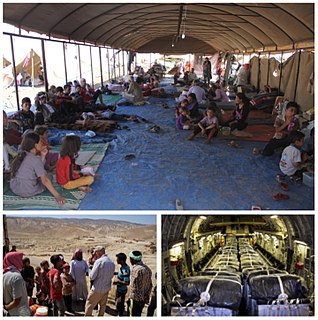
The Genocide of Yazidis by the Islamic State was carried out in the Sinjar area of northern Iraq in the mid-2010s. The genocide led to the expulsion, flight and effective exile of the Yazidis. Thousands of Yazidi women and girls were forced into sexual slavery by ISIL, and thousands of Yazidi men were killed. Five thousand Yazidi civilians were killed during what has been called a "forced conversion campaign" carried out by ISIL in Northern Iraq. The genocide began after the withdrawal of Iraqi forces and Peshmerga, which left the Yazidis defenseless.
Collaboration with the Islamic State refers to the cooperation and assistance given by governments, non-state actors, and private individuals to the Islamic State (IS) during the Syrian Civil War, Iraqi Civil War, and Libyan Civil War.
Al-Barakah is a Syrian administrative district of the Islamic State (IS), a Salafi jihadist militant group and unrecognised proto-state. Originally set up as al-Barakah Province to govern ISIL territories in al-Hasakah Governorate, the province shifted south after 2016 due to the territorial losses to the YPG/YPJ. Having been demoted from province to district in 2018, al-Barakah administered a small strip of land along the Euphrates in Deir ez-Zor Governorate until the Battle of Baghuz Fawqani, since then the "territory" has turned into an insurgency.

On June 10, 2014, the Islamic State of Iraq and the Levant took control of Mosul, after the Iraqi troops stationed there fled. Troop shortages and infighting among top officers and Iraqi political leaders played into ISIL's hands and fueled panic that led to the city's abandonment. Kurdish intelligence had been warned by a reliable source in early 2014 that ISIL would attack Mosul, and ex-Baathists had informed the U.S. and the UK, but Iraqi Prime Minister Nouri al-Maliki and the Defence Minister turned down repeated offers of help from the Peshmerga. Half a million people escaped on foot or by car during the next two days.













